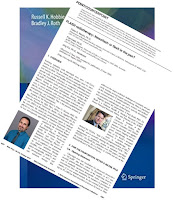 |
| “Can the Microwave Auditory Effect be Weaponized?” |
As is my wont, I will present this mechanism as a homework problem at a level you might find in Intermediate Physics for Medicine and Biology. I’ll assign the problem to Chapter 13 about Sound and Ultrasound, although it draws from several chapters.
Forster et al. represent the wave as decaying exponentially as it enters the tissue, with a skin depth λ. To keep things simple and to focus of the mechanism rather than the details, I’ll assume the energy in the electromagnetic wave is absorbed uniformly in a thin layer of thickness λ, ignoring the exponential behavior.
Section 13.4
Problem 17 ½. Assume an electromagnetic wave of intensity I0 (W/m2) with area A (m2) and duration τ (s) is incident on tissue. Furthermore, assume all its energy is absorbed in a depth λ (m).
(a) Derive an expression for the energy E (J) dissipated in the tissue.
(b) Derive an expression for the tissue’s increase in temperature ΔT (°C), E = C ΔT, where C (J/°C) is the heat capacity. Then express C in terms of the specific heat capacity c (J/°C kg), the density ρ (kg/m3), and the volume where the energy was deposited V (m3). (For a discussion of the heat capacity, see Sec. 3.11).
(c) Derive an expression for the fractional increase in volume, ΔV/V, caused by the increase in temperature, ΔV/V = αΔT, where α (1/°C) is the tissue’s coefficient of thermal expansion.
(d) Derive an expression for the change in pressure, ΔP (Pa), caused by this fractional change in volume, ΔP = B ΔV/V, where B (Pa) is the tissue’s bulk modulus. (For a discussion of the bulk modulus, see Sec. 1.14).
(e) You expression in part d should contain a factor Bα/cρ. Show that this factor is dimensionless. It is called the Grüneisen parameter.
(f) Assume α = 0.0003 1/°C, B = 2 × 109 Pa, c = 4200 J/kg °C, and ρ = 1000 kg/m3. Evaluate the Grüneisen parameter. Calculate the change in pressure ΔP if the intensity is 10 W/m2, the skin depth is 1 mm, and the duration is 1 μs.
I won’t solve the entire problem for you, but the answer for part d is
ΔP = I0 (τ/λ) [Bα/cρ] .
I should stress that this calculation is approximate. I ignored the exponential falloff. Some of the incident energy could be reflected rather than absorbed. It is unclear if I should use the linear coefficient of thermal expansion or the volume coefficient. The tissue may be heterogeneous. You can probably identify other approximations I’ve made.
Interestingly, the pressure induced in the tissue varies inversely with the skin depth, which is not what I intuitively expected. As the skin depth gets smaller, the energy is dumped into a smaller volume, which means the temperature increase within this smaller volume is larger. The pressure increase is proportional to the temperature increase, so a thinner skin depth means a larger pressure.
You might be thinking: wait a minute. Heat diffuses. Do we know if the heat would diffuse away before it could change the pressure? The diffusion constant of heat (the thermal diffusivity) D for tissue is about 10-7 m2/s. From Chapter 4 in IPMB, the time to diffuse a distance λ is λ2/D. For λ = 1 mm, this diffusion time is 10 s. For pulses much shorter than this, we can ignore thermal diffusion.
Perhaps you’re wondering how big the temperature rise is? For the parameters given, it’s really small: ΔT = 2 × 10–9 °C. This means the fractional change in volume is around 10–12. It’s not a big effect.
The Grüneisen parameter is a dimensionless number. I’m used to thinking of such numbers as being the ratio of two quantities with the same units. For instance, the Reynolds number is the ratio of an inertial force to a viscous force, and the Péclet number is the ratio of transport by drift to transport by diffusion. I’m having trouble interpreting the Grüneisen parameter in this way. Perhaps it has something to do with the ratio of thermal energy to elastic energy, but the details are not obvious, at least not to me.
What does this all have to do with the Havana syndrome? Not much, I suspect. First, we don’t know if the Havana syndrome is caused by microwaves. As far as I know, no one has ever observed microwaves associated with one of these “attacks” (perhaps the government has but they keep the information classified). This means we don’t know what intensity, frequency (and thus, skin depth), and pulse duration to assume. We also don’t know what pressure would be required to explain the “victim’s” symptoms.
In part f of the problem, I used for the intensity the upper limit allowed for a cell phone, the skin depth corresponding approximately to a microwave frequency of about ten gigahertz, and a pulse duration of one microsecond. The resulting pressure of 0.0014 Pa is much weaker than is used during medical ultrasound imaging, which is known to be safe. The acoustic pressure would have to increase dramatically to pose a hazard, which implies very large microwave intensities.
 |
| Are Electromagnetic Fields Making Me Ill? |
Microwave weapons and the Havana Syndrome: I am skeptical about microwave weapons, but so little evidence exists that I want to throw up my hands in despair. My guess: the cause is psychogenic. But if anyone detects microwaves during an attack, I will reconsider.























